Introduction
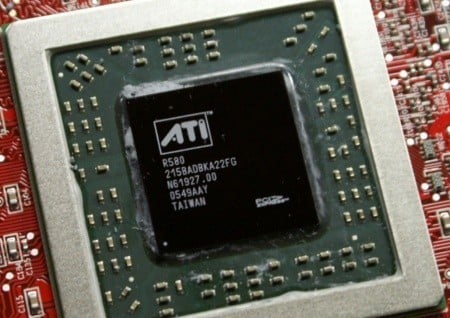
The benefits of being based out of Taipei in Taiwan are great for a person who runs a computer hardware website. You are always in the loop for all the latest news on upcoming product releases and there's always a story being told about something or someone in the industry.
In a move which we hope to be doing more of from now on, we bring you our first article which takes a first look at products which we test in Taiwan in our labs or at a computer company HQ. This enables us to bring the news to you earlier and to provide you with a more comprehensive look at the latest hardware, since some supplies sometimes forget about us when it comes to allocating review samples at launch time.
Moving forward, our friends at Gigabyte were kind enough to kick off the trend by letting us into their offices down south of Taipei for a full day last week to test ATI's new R580 graphics card. The R580 is a refresh version of the R520 GPU (X1800 series) and comes under the name of the X1900 series; specifically we are testing the most high-end X1900XTX 512MB today.
There have been claims floating around the web that the X1900XTX will out perform nVidia's 7800GTX 512 GPU but what ATI should really be focusing on is kicking butt against the current high-end GPU from nVidia since the G71 (likely called GeForce 7900) should be coming out around CeBIT time (March 2006) and nVidia are claiming huge performance increases for their next GPU.
Unfortunately we didn't have any access to a GeForce 7800GTX 512MB graphics card here in Taiwan for comparison but we're comparing ATI's X1900XTX (which should be available for ordering today as ATI have had enough bad press and complaints from customers to hopefully get it right this time around) against the X1800XT and dual X1800XT in Crossfire. This article will be centered around a performance look at the product since we were not briefed on the new GPU from ATI officially but we'll also include some pictures and basic specifications on the next page for your information.
Let's get started and find out what ATI have managed to do with their latest graphics cards in terms of performance!
A closer look at the Radeon X1900XTX
Visually, in many ways the X1900XTX is quite similar to the X1800XT. Both are the same size, weigh the same, both use the same reference cooler and the PCB layout is pretty much identical. Again, a very heavy duty dual slot cooling solution is used like the X1800XT which is used to exhaust hot air out the back of your case. You also will still find the 6-pin power connector as the PCI Express connector is not able to provide enough power for the X1900XTX.
The X1900XTX we tested at the Gigabyte offices is actually a reference sample with a Gigabyte sticker on it. Don't be alarmed though; initially ATI make all the graphics cards for their customers and later on companies such as Gigabyte may choose to make the card themselves and push for higher clock speeds and maybe attach some fancy cooler which is quieter or has some type of special features.
The X1900XTX comes with default clock speeds of 650MHz on the core and 775MHz (1550MHz DDR) on the memory which seems to be yielding well for ATI and comes with a total of 512MB of memory. The memory used (K4J52324QC-BJ11) on the XTX version of the X1900 series is very fast (and expensive) GDDR-3 memory from Samsung at 1.1ns which operates at 2.0 volts. That means it is capable of running at 900MHz or 1800MHz DDR - which is of course, extremely fast. This could be an indicator that the XTX will be a good overclocker in the memory department and later on companies might bring out X1900XTX OC version with some insane memory clock speeds to help keep nVidia on their toes.
Compared to the previous generation X1800XT, the X1900XTX is only a little quicker in terms of the pure clock speed numbers. The X1800XT has a core clock speed of 625MHz and memory clock speed of 750MHz (or 1500MHz DDR) using 1.2ns memory. Don't let the pure clock speeds numbers fool you though as the X1900XTX is able to process a lot more per clock in terms of shader performance. The X1900XTX has 16 pixel pipelines each with three pixels shaders for a total of 48 shaders compared to a maximum of 24 pixel pipelines on the GeForce 7800GTX 512. The X1800XT only has 16 pixel pipelines, so the increase in processing power is huge.
A closer look at the Radeon X1900XTX Continued
There is also another version of the X1900 called the X1900XT which is a slightly cut down and cheaper version of the X1900XTX - because the required yields aren't as tough, you might end up having better chances of buying the X1900XT especially if quantities are low.
However, Gigabyte told us they already have stock of the X1900XTX for their customers around the world, so that is at least a good sign for ATI and ATI fans alike who are sick of the past few paper launches by ATI. The core clock speed is 925MHz compared to 950MHz and memory used is also 50MHz (100MHz DDR) slower. Not having seen or tested the slower X1900XT, we would have to take an educated guess that it uses Samsung K4J52324QC-BJ12 GDDR-3 memory which runs at 1.2ns or up to 800MHz (or 1600MHz DDR), just like the X1800XT uses. We have no official details on pricing of either card at this stage but we would estimate the X1900XTX selling for around $600 - $650 USD at launch with the X1900XT coming in at around $525 - $550 USD.
As far as overclocking goes, we didn't have too much success. The memory on the X1900XTX was pushed to the maximum which ATI's CCC "overdrive" feature supports, which is 900MHz (1800MHz DDR), and it seemed to handle that part without any issues but the core was a let down. The GPU would operate at speeds between 690MHz and 670MHz for a little while but would eventually crash in all versions of 3DMark due to what we believe is heat related issues.
Hence, it would seem like the 650MHz rated default core clock speed of the X1900XTX is a fairly high and non-conservative rating with maybe only 10 - 15MHz left in it for stable operation with the stock cooler. Of course, if you attach a different cooler or water cooling or other extreme cooling methods, you'll most likely get more out of the core but it just operates too hot as is in 3D applications to get much more out of it - at least with the reference sample we tested with anyway.
That pretty much covers the summary of the new X1900XTX graphics card. Before we move onto the benchmarks though, it looks like AGP users are dead out of luck as ATI doesn't have any plans for an AGP version of the X1900XTX, just PCI Express. Some other companies may attempt an AGP version of the X1900XTX but it doesn't seem likely as the industry is pushing forward with PCI Express.
Let's move onto the benchmarks now and see what ATI has to deliver.
Benchmarks - Test System Setup and 3DMark03
Test System Setup
Processor: Intel Pentium EE 840 (3.73GHz) Smithfield
Motherboard: Gigabyte G1-975X
Memory: 2 x 1GB DDR-2 533
Hard Disk: Western Digital 120GB SATA
Operating System: Windows XP Professional SP2
Drivers: ATI Catalyst 6.1 and DX9c
As mentioned in the introduction, we unfortunately couldn't get hold of a GeForce 7800GTX 512 graphics card, so our benchmarks here today will be ATI vs. ATI. We do however have a fairly high-end Intel test bed to work with which should suit the new X1900XTX just fine with one of the fastest Intel processors out and the new Intel 975X gamers chipset based on a motherboard from Gigabyte which supports Crossfire without any issues.
We're comparing the brand new Radeon X1900XTX against a single and dual X1800XT configuration to see just where the new graphics card from ATI sits in the performance standings. The X1900XTX has a lot of power under the hood, so we're expecting some decent increases.
For some reason we couldn't get the Crossfire setup to work at 1600 x 1200 so we only included 1024 x 768 results for the dual X1800XT configuration. We're unsure when X1900 series Crossfire cards will be available but we would expect them to be coming out in a month or two according to what we've heard. There was a rumor going around at the Gigabyte office that a master card was not needed for X1900 Crossfire but this is untrue, a master card is required for the dual graphics setup.
3DMark03
Version and / or Patch Used: Build 360
Developer Homepage: http://www.futuremark.com
Product Homepage: http://www.futuremark.com/products/3dmark03/
Buy It Here
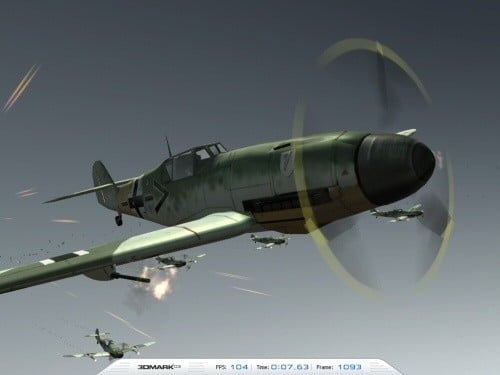
By combining full DX8 and partial DX9 support with completely new tests and graphics over the previous version, 3DMark03 continues the legacy of being the industry standard 3D benchmark.
Please Note: Due to recent events with the 3DMark03 series, we are adding results purely for those who are still in favor of 3DMark03. These results should not be taken too seriously and are only added for interest sakes.
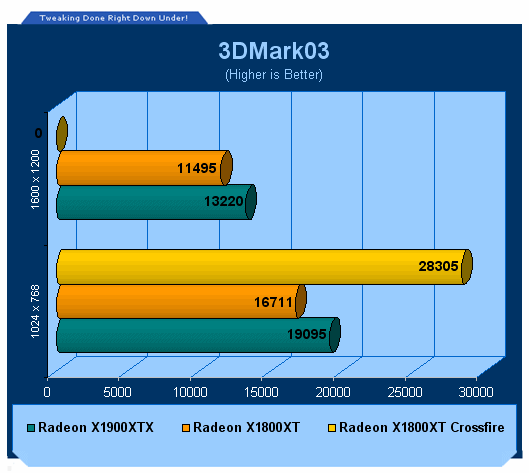
In our first test we can see the dual X1800XT Crossfire setup has a demanding lead but what's most important for us is the lead which the X1900XTX has over the X1800XT, which is around 15% even in a less intensive 3D application like 3DMark03 which is now aging.
Benchmarks - 3DMark05
3DMark05
Version and / or Patch Used: Build 120
Developer Homepage: http://www.futuremark.com
Product Homepage: http://www.futuremark.com/products/3dmark05/
Buy It Here

3DMark05 is now the second latest version in the popular 3DMark "Gamers Benchmark" series. It includes a complete set of DX9 benchmarks which tests Shader Model 2.0 and higher.
For more information on the 3DMark05 benchmark, we recommend you read our preview here.
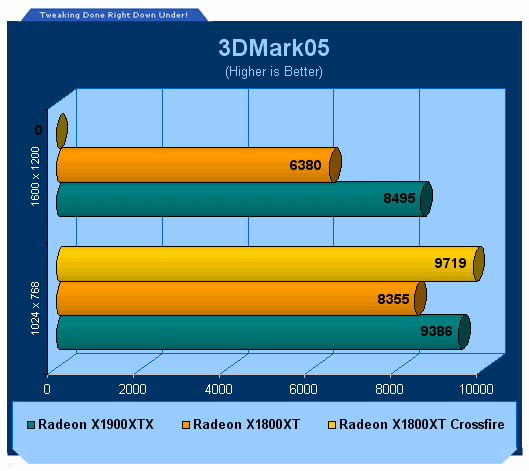
As we move to 3DMark05 which is more 3D intensive than 3DMark03, we see the performance increase of the X1900XTX move to be a little over 33% quicker than the older X1800XT. Here the gap between the X1900XT and X1800XT Crossfire is also lessened suggesting good things for ATI's new GPU.
Benchmarks - 3DMark06
3DMark06
Version and / or Patch Used: Build 1.02
Developer Homepage: http://www.futuremark.com
Product Homepage: http://www.futuremark.com/products/3dmark06/
Buy It Here
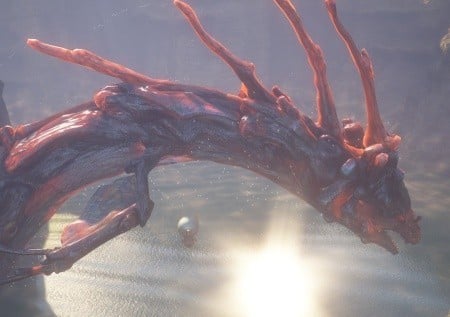
3DMark06 is the very latest version of the "Gamers Benchmark" from FutureMark. The newest version of 3DMark expands on the tests in 3DMark05 by adding graphical effects using Shader Model 3.0 and HDR (High Dynamic Range lighting) which will push even the best DX9 graphics cards to the extremes.
3DMark06 also focuses on not just the GPU but the CPU using the AGEIA PhysX software physics library to effectively test single and Dual Core processors.
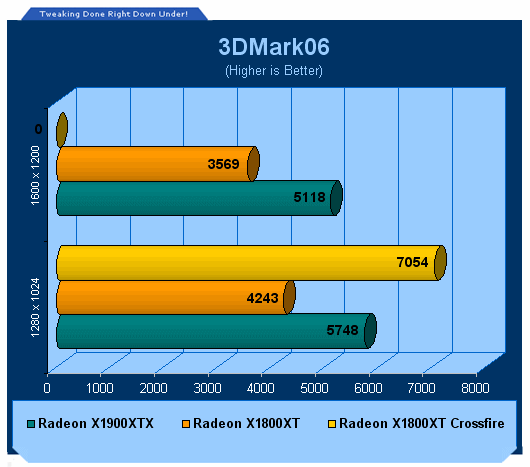
In the very latest version of the 3D intensive 3DMark06 we see at the higher resolution that the X1900XTX performing around 43% faster than the X1800XT. The X1800XT Crossfire setup gives the X1900XTX a good beating but the vastly improved performance of the X1900XTX seems to suggest good things for users who may want to use X1900XTX Crossfire later on.
Benchmarks - Doom 3
Doom 3
Version and / or Patch Used: Unpatched
Timedemo or Level Used: Custom Timedemo
Developer Homepage: http://www.idsoftware.com
Product Homepage: http://www.doom3.com
Buy It Here
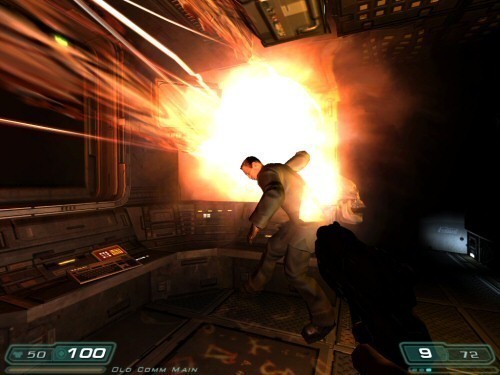
Doom 3 is the latest game to hit our test lab and is one of the most intensive games to dates. With our own custom time demo we are able to give a realistic rating on what kind of FPS you will be achieving.
For more information on benchmarking Doom 3 we recommend you check out our extensive article regarding it here.
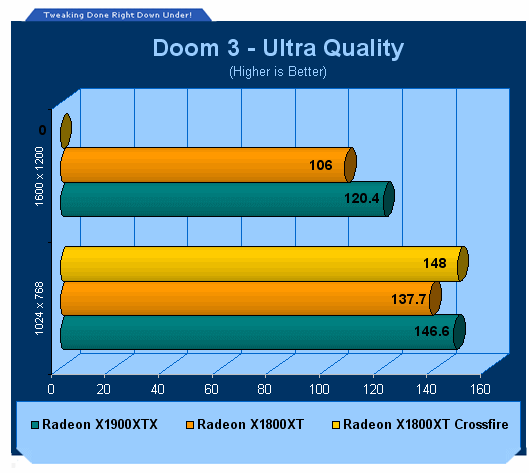
Doom 3 tends to rely on not just the GPU but also the CPU and memory parts of the system. At the lower resolution, performance is all pretty much the same. It is not until you increase the resolution that the X1900XTX sees an increase of about 14% over the X1800XT.
Benchmarks - Quake 4
Quake 4
Version and / or Patch Used: Unpatched
Timedemo or Level Used: Custom Timedemo
Developer Homepage: http://www.idsoftware.com
Product Homepage: http://www.quake4game.com
Buy It Here
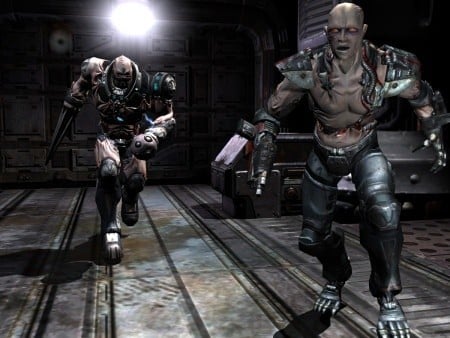
Quake 4 is one of the latest new games to be added to our benchmark suite. It is based off the popular Doom 3 engine and as a result uses many of the features seen in Doom. However, Quake 4 graphics are more intensive than Doom 3 and should put more strain on different parts of the system.
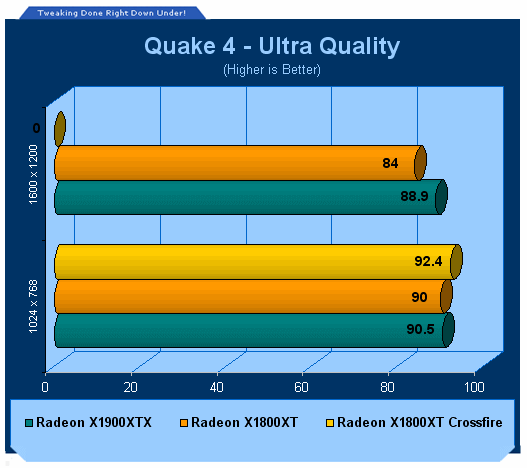
We see a similar story here but the numbers are even closer which tells us that the CPU is a bottleneck.
Benchmarks - Half Life 2
Half Life 2
Version and / or Patch Used: Unpatched
Timedemo or Level Used: Custom Timedemo
Developer Homepage: http://www.valvesoftware.com
Product Homepage: http://www.half-life2.com
Buy It Here
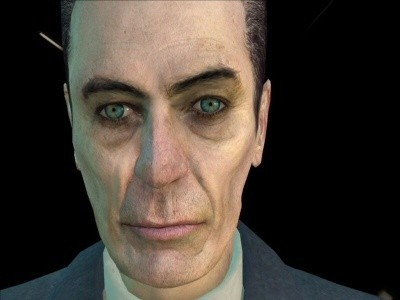
By taking the suspense, challenge and visceral charge of the original, and adding startling new realism and responsiveness, Half-Life 2 opens the door to a world where the player's presence affects everything around him, from the physical environment to the behaviors even the emotions of both friends and enemies.
We benchmark Half Life 2 with our own custom timedemos as to avoid possible driver optimizations using the "record demo_name" command and loading the timedemo with the "timedemo demo_name" command - For a full list of the commands, click here.
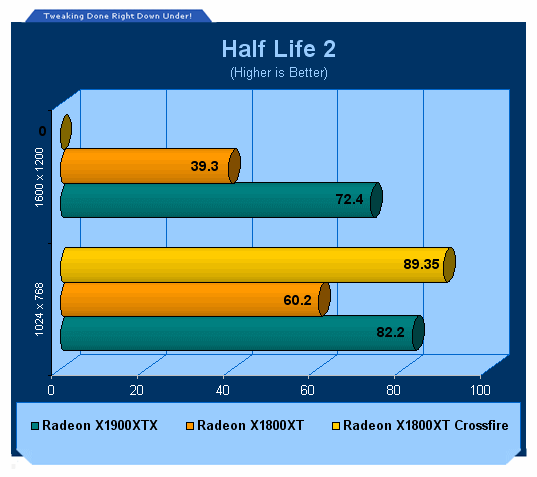
Half Life 2 is the first benchmark where we start to see huge performance increases for the X1900XTX. At the higher resolution the X1900XTX is a massive 84% quicker than the X1800XT and the X1900XTX is only just behind the dual X1800XT Crossfire configuration.
Needless to say, the real power of the X1900XTX is exploited very well in Half Life 2.
Benchmarks - Far Cry
Far Cry
Version and / or Patch Used: 1.3
Timedemo or Level Used: Ubisoft Volcano
Developer Homepage: http://www.crytek.com
Product Homepage: http://www.farcrygame.com
Buy It Here

There is no denying that Far Cry is currently one of the most graphic intensive games on the market, utilizing PS2.0 technology (the latest versions support Shader Model 3.0 with DX9c) and offering an exceptional visual experience there is no denying that even some of the faster graphics cards struggle.
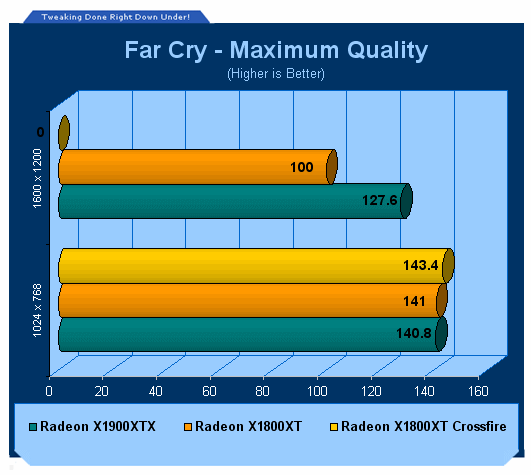
Far Cry is a game which is limited by the CPU and memory parts of the system, so at the lower resolution performance is pretty much the same. However, when we increase the resolution the performance enhancements of the X1900XTX are clear.
Benchmarks - High Quality AA and AF
High Quality AA and AF
In our High Quality tests we bump the Antialiasing (AA) and Anisotropic Filtering (AF) up causing the card(s) to be put under more load.
This usually helps us remove the CPU limitation. We use 4 x AA and 8 x AF as this is quite a common setup for most people who are venturing into the AA and AF area.
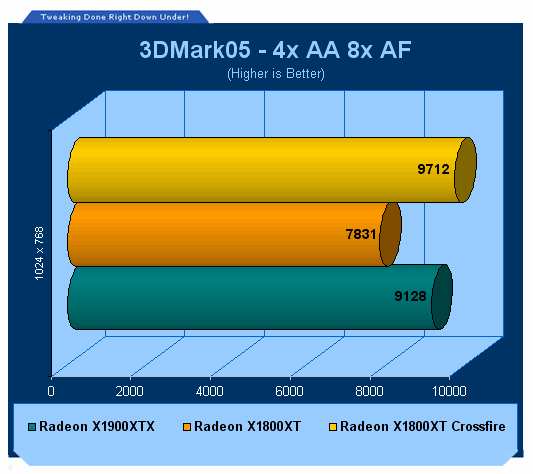
In the first of our high quality tests, the X1900XTX is even further ahead of the X1800XT when more intensive 3D action is applied.
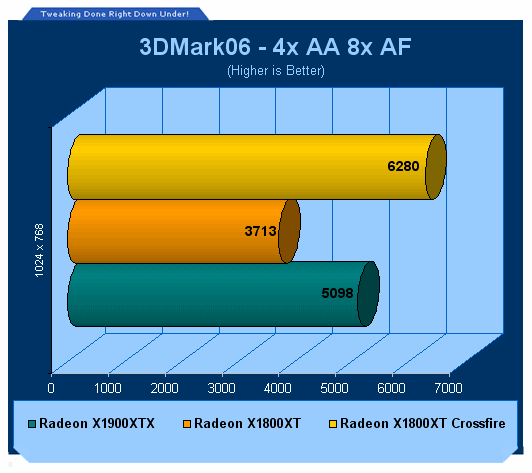
Here the X1900XTX is 37% faster than the X1800XT.
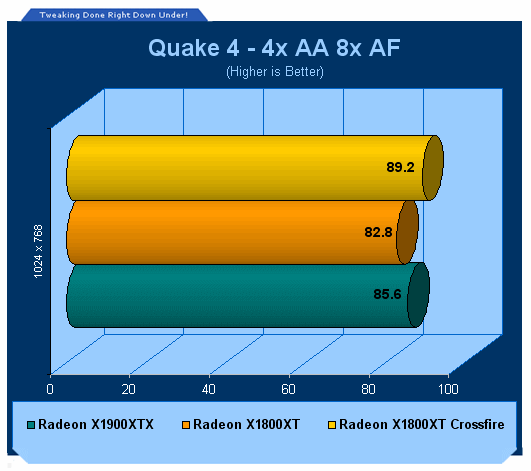
Quake 4 even with AA and AF enabled is still being bottlenecked by the CPU but the X1900XTX still manages to edge ahead.
Final Thoughts and Crossfire Update
Final Thoughts
After a full day of testing the ATI Radeon X1900XTX graphics cards at the Gigabyte offices here in Taiwan, we are pretty happy with the performance numbers we see from ATI's newest GPU. In our benchmarks we saw increases from 13% all the way up to 84% over the previous generation X1800XT which is fairly impressive.
As expected, the X1800XT Crossfire setup still manages to win every benchmark but that's because it is two GPU versus one. What we can all look forward to though is X1900XTX Crossfire which should offer some really serious performance, whenever ATI choose to release a master card version of the X1900 series.
If you've just bought a new X1800XT graphics card, should you upgrade to the newest from ATI? If you have plenty of money to spend and demand the best 3D gaming performance for your computer, then yes. Although, unless you are playing games at a resolution of 1600 x 1200 or above (with all the settings turned up), you won't start to see the performance advancements of the X1900XTX. Sure, we see the X1900XTX doing a good job of beating the X1800XT at the lower resolution but in most of the real-world game tests we don't see much of an improvement until the resolution is increased.
Sadly we couldn't compare the X1900XTX against the GeForce 7800GTX 512 but from what we can tell the new ATI GPU will be able to perform quite well against the GTX 512. The real question is, how will the X1900XTX perform against nVidia's upcoming G71 GPU which is due to be released in March of this year. And the second most important question is supply by ATI, especially at launch. ATI have been criticized over the past while for not having any product available at launch but from what we've heard this time around, ATI has well and truly heard the cries and moans from their customers and end-users and you should be able to buy the X1900XTX and X1900XT from today, the launch day!
If you're on the market for a new graphics cards and upgrading from something like an older Radeon X800, you'll be very pleased with the performance increases but if you've only just bought an X1800XT, you might want to wait a little while and see what nVidia will bring to the table in a couple of months with their G71 (GeForce 7900) GPU.
In closing, I want to send out a big "THANK YOU" to all the guys at Gigabyte from FAE, sales and marketing departments who all stopped by and had a chat and helped with everything throughout the day!
UPDATE from HONG KONG: While visiting the HIS (Hightech Information System) office here in Hong Kong yesterday, we were shown a bunch of new ATI based graphics cards. One which was of most interest to us was their Radeon X1900 Crossfire master card.
As far as we knew, X1900 series Crossfire master cards would not be available for some time but at least one of ATI's board partners already has their retail product ready and in fact, HIS started shipping Crossfire cards to their partners last week.
We weren't able to run any benchmarks of the card but our samples are already on the way to our labs and we'll have a full review of X1900 Crossfire online very soon.
ATI seems to be serious about not just having X1900XT and XTX cards ready at launch but even Crossfire!



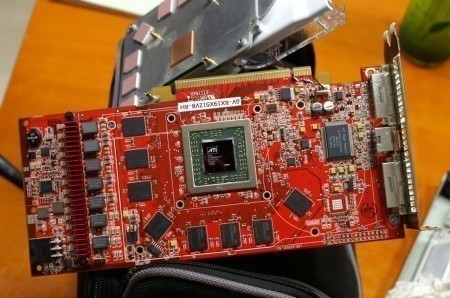
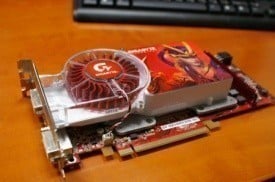
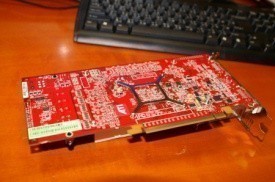
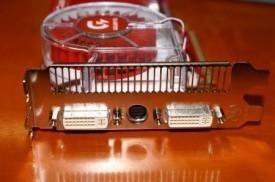
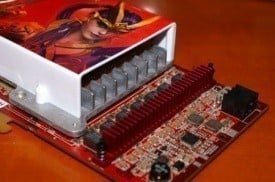
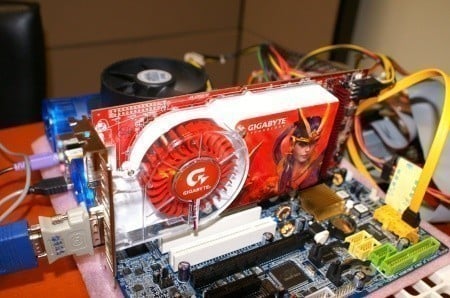
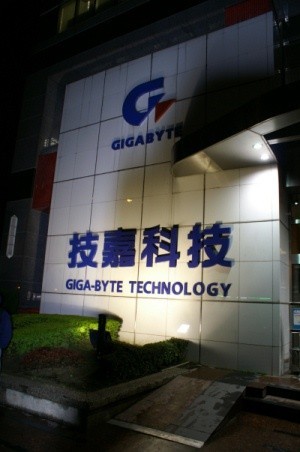
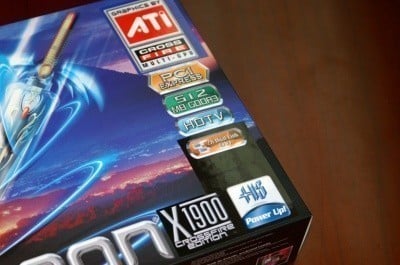
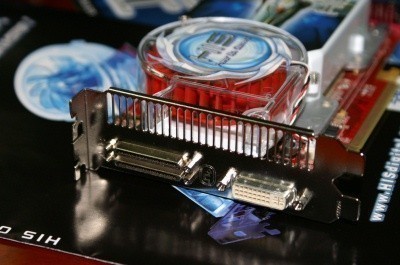
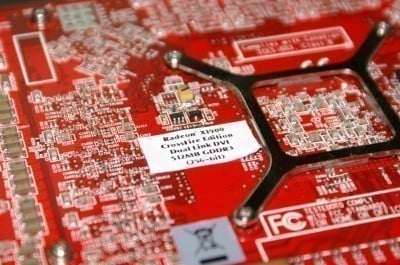
 United
States: Find other tech and computer products like this
over at
United
States: Find other tech and computer products like this
over at  United
Kingdom: Find other tech and computer products like this
over at
United
Kingdom: Find other tech and computer products like this
over at  Australia:
Find other tech and computer products like this over at
Australia:
Find other tech and computer products like this over at  Canada:
Find other tech and computer products like this over at
Canada:
Find other tech and computer products like this over at  Deutschland:
Finde andere Technik- und Computerprodukte wie dieses auf
Deutschland:
Finde andere Technik- und Computerprodukte wie dieses auf